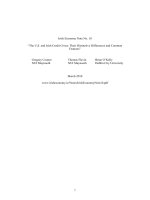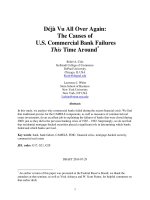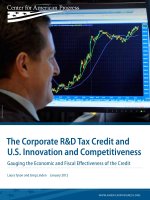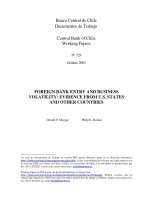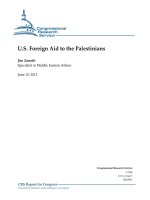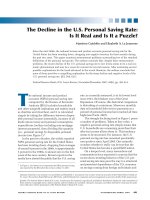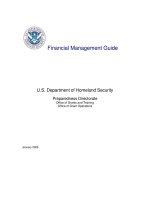U.S. Regulatory Actio n Items for Investment Advisers (2013) pdf
Bạn đang xem bản rút gọn của tài liệu. Xem và tải ngay bản đầy đủ của tài liệu tại đây (122.98 KB, 5 trang )
JONES DAY
COMMENTARY
© 2013 Jones Day. All rights reserved. Printed in the U.S.A.
Happy 2013 to clients and friends of Jones Day! We
wish you a happy, healthy, and prosperous new year.
Of course, a new year brings not only (the poten-
tial for keeping) New Year’s resolutions, but also a
new set of obligations and undertakings for many
investment advisers. We have outlined in Part I
herein some of these obligations for exempt report-
ing advisers (i.e., those relying on the private fund
exemption or the venture capital exemption) and, in
Part II, some obligations for investment advisers that
are registered with the U.S. Securities and Exchange
Commission (the “SEC”). In Part III, we address cer-
tain requirements and undertakings that may be rel-
evant for any investment adviser—whether registered,
filing as an exempt reporting adviser, or neither.
Part I: annual OblIgatIOns
aPPlIcable tO exemPt rePOrtIng
advIsers
1
ANNUAL FORM ADV UPDATE
Each exempt reporting adviser is required to update
its Form ADV Part 1 within 90 days of the end of its
fiscal year. In 2013 (a non-leap year), this deadline
is April 1 (as March 31 falls on a Sunday) for advisers
with December 31 fiscal year-ends.
1 Exempt reporting advisers should be aware of
obligations under the U.S. Investment Advisers Act
of 1940, as amended (the “Advisers Act”) to, at a
minimum (a) establish and maintain appropriate
written policies designed to prevent the misuse of
material nonpublic information, and (b) have and
enforce policies and procedures to comply with
the Advisers Act’s “pay to play” rule. See Jones
Day’s February 2012 publication for further infor-
mation regarding exempt reporting advisers,
available at />reporting_advisers/. All web sites herein last vis-
ited on January 18, 2013.
u.s. regulatOry actIOn Items fOr Investment
advIsers (2013)
JANUARY 2013
2
TIP: You should ensure that your IARD account is adequately
funded ($150 for exempt reporting advisers, plus any addi-
tional amount(s) for required state notice filings
2
) well in
advance of the filing deadline.
Part II: annual OblIgatIOns aPPlIcable
tO regIstered Investment advIsers
ANNUAL FORM ADV UPDATE
Each registered investment adviser is required to update its
Form ADV (Parts 1 and 2A) within 90 days of the end of its
fiscal year. In 2013 (a non-leap year), this deadline is April 1
(as March 31 falls on a Sunday) for advisers with December
31 fiscal year-ends.
Unlike the Form ADV Part 2A (the “brochure”), the Form ADV
Part 2B (the “brochure supplement”) is not required to be
filed with the SEC or delivered annually to clients (however,
the brochure supplement must be updated and delivered
to clients should there be material changes to any disci-
plinary information).
TIP: You should ensure that your IARD account is adequately
funded (generally $225 for registered investment advisers,
plus any additional amount(s) for required state notice fil-
ings
3
) well in advance of the filing deadline.
ANNUAL DELIVERY OF FORM ADV PART 2
A registered investment adviser must, within 120 days of
the end of its fiscal year, deliver to each client either (a) a
free updated brochure that either includes a summary
of material changes or is accompanied by a summary of
material changes, or (b) a summary of material changes that
includes an offer to provide a copy of the updated brochure
and information on how a client may obtain the brochure.
4
2 The state notice filings are made through an investment
adviser’s IARD renewal account.
3 The state notice filings are made through an investment
adviser’s IARD renewal account.
4 Advisers may deliver their brochures electronically—
see SEC interpretive guidance on delivering documents
electronically, available at />concept/33-7288.txt.
TIP: You should review your compliance manual to con-
firm whether it requires you to take the approach in (a) or
(b) above and whether, in respect of any private investment
funds that you advise, you must make such an annual deliv-
ery only to your “clients” (e.g., the private investment funds
that you advise) or also to the investors in those funds.
FORM PF
Investment advisers to “hedge funds,” “private equity funds,”
and/or “liquidity funds” (as those terms are defined in Form
PF) that meet the Form PF filing thresholds (but that were
not required to file the Form PF in 2012) must make their ini-
tial filings in 2013. The frequency and the timing of the Form
PF filings are based on the type of funds managed by the
investment adviser, the amount of the investment adviser’s
assets under management in those funds, and the date of
the investment adviser’s fiscal year-end.
See Jones Day’s November 2011 publication for further
information regarding Form PF, available at http://www.
jonesday.com/sec-adopts-new-risk-reporting-requirements-
for-certain-registered investment-advisers-to-private-
funds-form-pf-11-04-2011/.
TIP: Many private investment funds that may not typically be
considered “hedge funds” (for example, real estate funds)
may actually qualify as “hedge funds” under the Form PF
definition of “hedge fund” depending upon their level and
type of borrowing and short selling. (See the Form PF at
(page
57) for the definition of a “hedge fund”.)
COMPLIANCE REVIEW
Registered investment advisers are required to annually per-
form and document an annual review of their compliance
policies and procedures to ascertain their effectiveness
under the Advisers Act.
TIP: Make sure that any revisions to your compliance policies
and procedures are reflected in your Form ADV Part 2A and/
or offering documents, if applicable.
3
DISTRIBUTION OF PRIVACY POLICY, PROXY NOTICE,
AND CODE OF ETHICS
Each registered investment adviser must annually distribute
its privacy policy, its current code of ethics (if distribution is
required by the investment adviser’s compliance manual), and
information as to how to obtain proxy vote records.
TIP: You should refer to your compliance manual to determine
who must receive this information/documentation (for exam-
ple, whether it requires you to distribute your annual privacy
notice to all investors or just natural person investors).
DISTRIBUTION OF ANNUAL AUDITED FINANCIAL
STATEMENTS
If an investment adviser uses the audited financial state-
ment exception to the surprise examination requirements
under the Custody Rule in respect of the private funds that
it manages (and those funds have December 31 fiscal year-
ends), the investment adviser should mark July 1 (for funds
of funds, as June 29 falls on a Saturday) or April 30 (for all
other funds) on its compliance calendar as the deadline for
distributing 2012 fiscal year audited financial statements to
fund investors.
TIP: If you take advantage of the audited financial statement
exception, make sure that you satisfy all requirements of
that exception, such as the requirement that the accountant
performing the annual audit of the fund be registered with
and subject to regular inspection by the Public Company
Accounting Oversight Board. For further information on the
audited financial statement exception (and the Custody Rule
generally), please refer to the SEC’s FAQ on the Custody
Rule, available at />custody_faq_030510.htm.
Part III: annual OblIgatIOns and
undertakIngs POtentIally aPPlIcable
tO any Investment advIser
REVIEW OF AND UPDATE TO OFFERING MATERIALS
To ensure compliance with federal and state securities
laws (anti-fraud laws in particular), it is a good practice for
an investment adviser to periodically review and update
the offering documents for its funds that are currently
being offered. In the context of such a private investment
fund, among the types of changes for which an investment
adviser may want to consider whether an update is neces-
sary are modifications to investment strategy, instruments
in which the fund may invest, service providers to the fund,
risk factors related to market conditions, conflicts of interest,
and applicable legal, tax, and regulatory matters.
TIP: Make sure that your subscription documents reflect the
Dodd-Frank-based adjustments to the accredited investor
and qualified client standards.
LOBBYIST REGISTRATION REQUIREMENTS
Any investment adviser that solicits monies from public pen-
sion plans may be required to make filings in certain juris-
dictions under those jurisdictions’ lobbying laws. Many
jurisdictions require annual (New York City) or biannual
(California) registration of lobbyists and lobbyist agents.
TIP: Investment advisers should be aware that the definition
of “lobbyist” in a jurisdiction (such as a state, city or munici-
pality) in which they—or their agents—solicit public pen-
sion plans as clients or investors may have been revised
to explicitly include placement agents (which in turn may
trigger a registration requirement). It is helpful to consult
with the relevant laws and regulations regarding lobbyist
registration requirements, as lobbying registration forms
may not contain the most updated information regarding
registration requirements.
NEW ISSUES CERTIFICATIONS
If a fund may purchase “new issues,” its broker (or, for
funds of funds that invest in funds investing in new issues,
the underlying fund(s)) will likely request that the fund com-
plete an annual certification (certifying whether the fund is
a restricted person under the Financial Industry Regulatory
Authority (“FINRA”) Rule 5130 and/or Rule 5131). In order to
complete that certification, the investment adviser to that
fund will need to confirm that there has been no change to
the restricted status of its investors.
TIP: Make sure that any new issues questionnaire in the
subscription documents for the funds that you manage has
been updated to cover Rule 5131 and that you have received
representations from existing investors as to their respective
4
statuses under Rules 5130 and 5131. Be aware that if you fail
to respond to a request for annual certification, the broker or
underlying fund may deem you to have represented that you
are a restricted person under Rules 5130 and 5131.
FORM D FILINGS
Annual electronic Form D renewal filings for each issuer of
securities in a continuous offering is required by the SEC
and certain states.
5
TIP: A mandatory capital commitment call for a private
fund does not constitute a new offering but is deemed to
have been made as part of the original offering, so no new
Form D filing is required.
If a continuous offering has in fact been terminated, in order
to reflect that fact, an investment adviser may want to con-
sider filing a final amended Form D with the SEC and with
those states that require notification that sales will no longer
be made in that state.
BLUE SKY AND WORLD SKY LAWS
Investment advisers should make sure that they have main-
tained and updated a record of the state and country of res-
idence of clients and fund investors and that any required
blue and world sky filings have been made.
TIP: Many blue sky filings must be renewed on a periodic
basis (for example, annually).
CFTC RULE 4.13(a)(3) REAFFIRMATION
Investment advisers which have filed a notice with the
National Futures Association (“NFA”) to claim their U.S.
Commodity Futures Trading Commission (“CFTC”) Rule
4.13(a)(3) exemption should be aware that their eligibility
must be electronically reaffirmed with NFA, generally not
later than 30 days after calendar year-end (i.e., January 30).
5 Form D must also be amended (for any offering) to cor-
rect a material mistake of fact or error in the previously
filed notice and, subject to certain exceptions, to reflect
a change in the information provided in the previously
filed notice.
TIP: In 2013 only, firms will have 60 days after December 31,
2012 (i.e., March 1, 2013) to provide the NFA with the appli-
cable notice of exemption.
SCHEDULES 13D AND 13G
Schedule 13G filings must be updated within 45 days of the
end of each calendar year (February 14), unless there is no
change to any of the information reported in the previous fil-
ing (except the holder’s percentage ownership due solely to
a change in the number of outstanding shares).
Schedule 13D filings must be amended “promptly” upon the
occurrence of any “material changes.”
TIP: Consider whether you may be subject to any reporting
obligations, or potential short-swing profit liability, under
Section 16 of the U.S. Securities Exchange Act of 1934,
as amended.
FORM 13F
Institutional investment advisers with investment discretion
over $100 million of certain equity securities (“Section 13(f)
securities”) must file quarterly reports on Form 13F (within 45
days of the end of each calendar quarter). The next quar-
terly filing deadline is February 14.
TIP: The official list of current and past Section 13(f)
securities is available at />investment/13flists.htm.
FORM 13H
Annual amendments for “large traders” (persons effecting
transactions in certain securities in amounts equal to 2 mil-
lion shares or $20 million in one calendar day or 20 million
shares or $200 million in one calendar month) are due within
45 days of the end of each calendar year (February 14).
TIP: If any of the information contained in a Form 13H filing
becomes inaccurate for any reason, a large trader must make
an amended filing no later than the end of the calendar quar-
ter in which the information became stale. If a large trader
files an amended Form 13H to reflect changes that occurred
during the fourth calendar quarter, the large trader is still
required to file the mandatory annual updated Form 13H.
This Commentary should be considered guidance only and should not be relied upon as legal advice. The contents may not be quoted or referred
to in any other publication or proceeding without the prior written consent of the Firm, to be given or withheld at our discretion. To request reprint
permission for any of our publications, please use our “Contact Us” form, which can be found on our web site at www.jonesday.com. The mailing
of this publication is not intended to create, and receipt of it does not constitute, an attorney-client relationship. The views set forth herein are the
personal views of the authors and do not necessarily reflect those of the Firm.
lawyer cOntacts
For further information, please contact your principal Firm representative or one of the lawyers listed below. General email
messages may be sent using our “Contact Us” form, which can be found at www.jonesday.com.
Michael R. Butowsky
New York
+1.212.326.8375
Robert C. Lee
Chicago
+1.312.269.4173
Kent R. Richey
New York
+1.212.326.3481
Eric Stuart
London
+44.20.7039.5959
Dennis Barsky
Singapore
+65.6233.5959
Emily O. Harris
Washington
+1.202.879.4653
David S. Phillips
Atlanta
+1.404.581.8439
Randall B. Schai
San Francisco
+1.415.875.5803
Alice Yurke
New York
+1.212.326.3623
Michele (Mitch) Gibbons
Houston / New York
+1.832.239.3788 / +1.212.901.7313
Anthony L. Perricone
New York
+1.212.326.7871
John M. Saada, Jr.
Cleveland
+1.216.586.7089
Joel S. Telpner
New York
+1.212.326.3663

